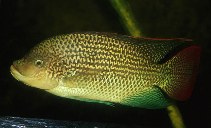| Family: |
Cichlidae (Cichlids), subfamily: Pseudocrenilabrinae |
| Max. size: |
42 cm TL (male/unsexed) |
| Environment: |
benthopelagic; freshwater |
| Distribution: |
Africa: endemic to Lake Tanganyika, in the coastal area and river mouths (Ref. 5166, 118630). |
| Diagnosis: |
Dorsal spines (total): 15-17; Dorsal soft rays (total): 11-15; Anal spines: 3-3; Vertebrae: 30-31. Diagnosis: A large, deep-bodied species, with wide bands of teeth in the jaws (Ref. 118638). Adult males are covered with complex bright pale blue markings, over the head, flanks and unpaired fins; the background colour can vary from greyish, through yellow to bright red; the lower part of the head is grey-white; the tailfin often head a red background and the dorsal fin has a broad red margin (Ref. 118638). Females and non-territorial males are generally a plain silvery colour, with pearly spots on the flanks; they occasionally exhibit vertical bars and/or horizontal dark bars (Ref. 118638).
Description: The teeth, with their long slender shafts are similar to those of Oreochromis karomo, but are arranged parallel to the edge of the jaw in irregular, close-set rows; in the young the outermost row in both jaws consists of bicuspid teeth; these gradually become replaced by tricuspids, beginning with the lower jaw, then the median teeth of the upper and finally all the outer teeth; the first tricuspid replacement teeth are asymmetrical, the median cusp being smaller than the lateral; in older fishes there are two or three rows on the outer side of the lower lip; they appear to have been pushed on to the outer side of the jaw by the expansion of the tooth-band; they are shorter than those of the third or fourth row, which now take their place on the edge of the jaw (Ref. 2). The pharyngeal teeth are small and crowded, but the posterior are compressed and have a distinct shoulder; they are less slender and reduced than those of Sarotherodon galilaeus; the toothed area is heart-shaped (Ref. 2). Gill rakers 3-4 + 1-2 + 22-26; microbranchiospines on the outersides of arches 2-4 (Ref. 2). Scales in the lateral line series almost constantly 32-33; 4.5 between origin of dorsal and lateral line; 16-18 around caudal peduncle; transition between the small scales of chest and belly and the bigger flank scales rather abrupt (Ref. 2). Dorsal fin rather high, the last spine measuring 15.5-17.0% of standard length in fishes of 100-230 mm standard length, about 14% in those over 300 mm standard length, the third anal 11.5-15.8% in the same group; longest soft dorsal rays prolonged in mature male to a vertical about half way along the caudal; caudal emarginate (Ref. 2).
Colouration: The general colour is greenish, white on the belly, and there are both dark and pale spots on the vertical fins; each scale carries a brownish or pink spot, and has an iridescent margin (Ref. 2). |
| Biology: |
It is the dominant tilapiine species in Lake Tanganyika, despite the presence of the normally invasive Nile tilapia (Ref. 118638). It is not normally found far up into inflowing rivers (Ref. 118638). It has been reported to browse the surface film of sheltered waters; stomachs contained large quantities of the diatoms Pinnularia and Navicula with some sand-grains (Ref. 2). A maternal mouthbrooder; males defend territories in shallow water in sheltered sandy or muddy areas, and dig simple pits in the substrate (Ref. 118638). A large fast-growing species well represented in fishery catches in and around Lake Tanganyika; currently being promoted as an aquaculture species and occasionally exported for the aquarium trade (Ref. 118638). |
| IUCN Red List Status: |
Least Concern (LC); Date assessed: 31 January 2006 Ref. (130435)
|
| Threat to humans: |
harmless |
Source and more info: www.fishbase.org. For personal, classroom, and other internal use only. Not for publication.
